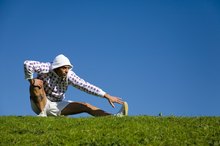Tensor Fasciae Latae Muscle Stretches
The tensor fasciae latae muscle, located on the side of your pelvis, helps to stabilize your hip through its connection into a strip of tough connective tissue on your outer thigh called the iliotibial band. Stretching a chronically contracted tensor fasciae latae can help improve the range of motion of your hips.
Tensor Fasciae Latae
The tensor fasciae latae attaches to the side of your pelvis. It inserts into the iliotibial band, a thick, strong band of connective tissue that runs down the outside of your thigh to just below your knee. When the tensor fasicae latae contracts, it tightens the iliotibial band, hence its name, which means "tensor of the lateral fascia." By tightening the iliotibial band, the muscle stabilizes the pelvis and thigh. It also abducts the thigh, moving it away from the body, as well as internally rotating the thigh and flexing the hip.
- The tensor fasciae latae attaches to the side of your pelvis.
- By tightening the iliotibial band, the muscle stabilizes the pelvis and thigh.
Standing Iliotibial Stretch
Stretches for Abductor Muscles
Learn More
For an easy tensor fasciae latae stretch, start in a standing position and cross your right leg behind your left leg. Your right foot should be to the outside of your left foot, with both feet pointing forward. Without tilting forward from your hips, lean the weight of your body over your right foot. Keep your hips pressing forward. Allow your left hip to drop slightly until you feel a stretch in your outer right hip. Hold the stretch for 10 to 30 seconds, then repeat, switching legs.
- For an easy tensor fasciae latae stretch, start in a standing position and cross your right leg behind your left leg.
- Allow your left hip to drop slightly until you feel a stretch in your outer right hip.
Wall Iliotibial Stretch
To use a wall to stretch your tensor fasciae latae, stand with your right side toward the wall, slightly more than arm's distance from the wall. Lean your right hand on the wall, with your right arm straight. Place your left hand on your hip. Keeping your legs and hips extended, move your pelvis toward the wall until you feel a stretch in your right outer hip. Contract your buttocks to press your hips forward. Hold for 10 to 30 seconds, then repeat, turning your left side toward the wall.
- To use a wall to stretch your tensor fasciae latae, stand with your right side toward the wall, slightly more than arm's distance from the wall.
- Keeping your legs and hips extended, move your pelvis toward the wall until you feel a stretch in your right outer hip.
Stretching Considerations
Stretching Exercises for ACL Injuries
Learn More
Before beginning your tensor fasciae latae stretching routine, warm up with a few minutes of light aerobic exercise, including some dynamic movements for your hips and legs. The American College of Sports Medicine recommends stretching at least two to three days per week, but it advises that more frequent stretching will yield greater gains in flexibility. Stretch only to the point of tightness or mild discomfort. Do not stretch to the point of pain.
- Before beginning your tensor fasciae latae stretching routine, warm up with a few minutes of light aerobic exercise, including some dynamic movements for your hips and legs.
- Do not stretch to the point of pain.
Related Articles
References
- Anatomy of Movement; Blandine Calais-Germain
- ExRx.net: Standing Iliotibial Band Stretch
- ExRx.net: Wall Iliotibial Band Stretch
- Medicine and Science in Sports and Exercise: American College of Sports Medicine Position Stand: Quantity and Quality of Exercise for Developing and Maintaining Cardiorespiratory, Musculoskeletal, and Neuromotor Fitness in Apparently Healthy Adults: Guidance for Prescribing Exercise
- Illiotibial Band Syndrome.
- Allen DJ. Treatment of distal iliotibial band syndrome in a long distance runner with gait re-training emphasizing step rate manipulation. Int J Sports Phys Ther. 2014;9(2):222–231.
Writer Bio
Joe Miller started writing professionally in 1991. He specializes in writing about health and fitness and has written for "Fit Yoga" magazine and the New York Times City Room blog. He holds a master's degree in applied physiology from Columbia University, Teacher's College.








